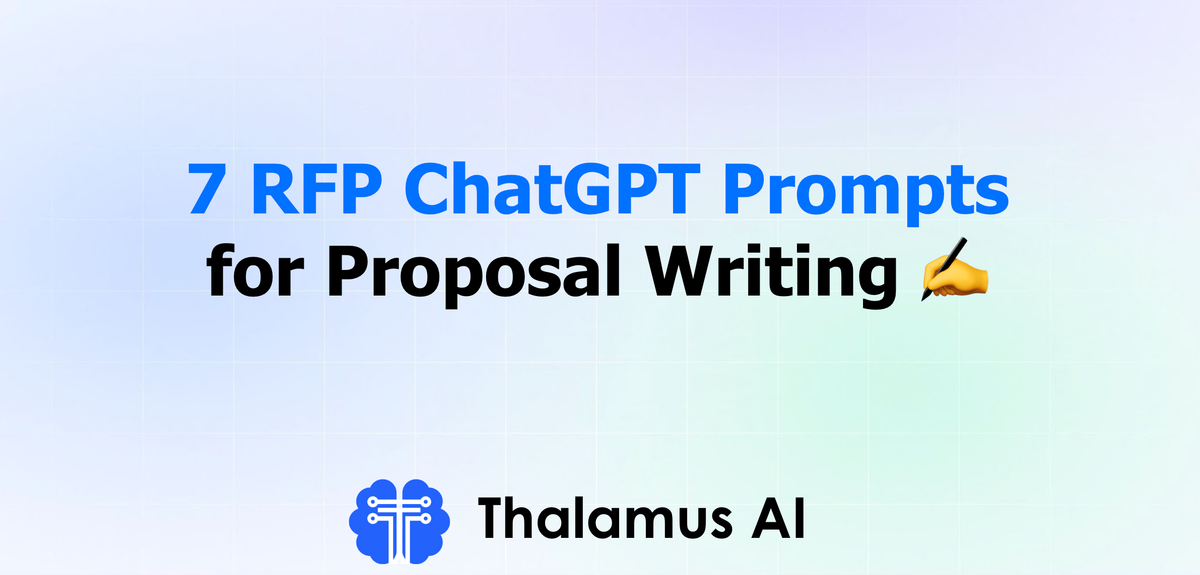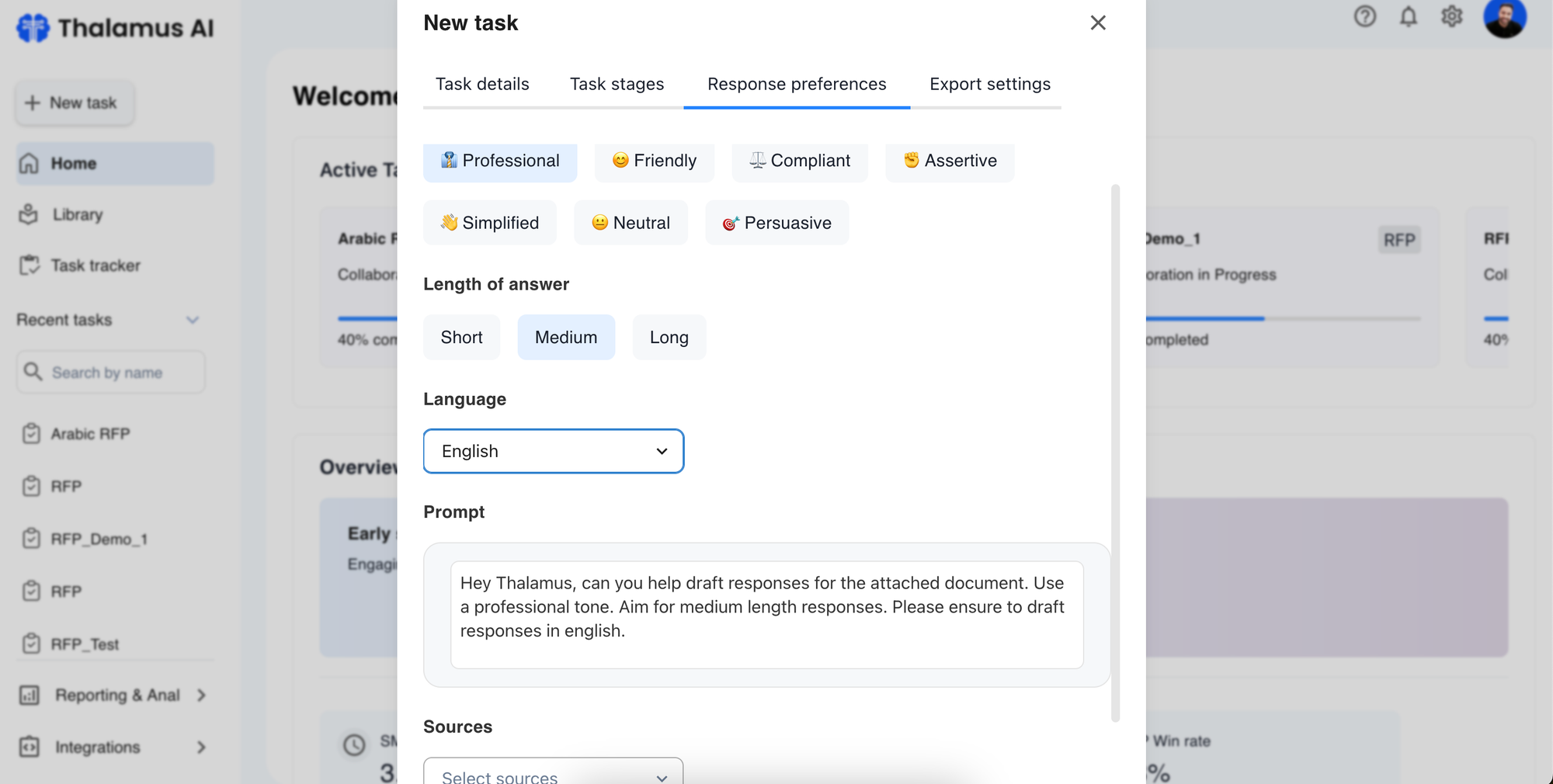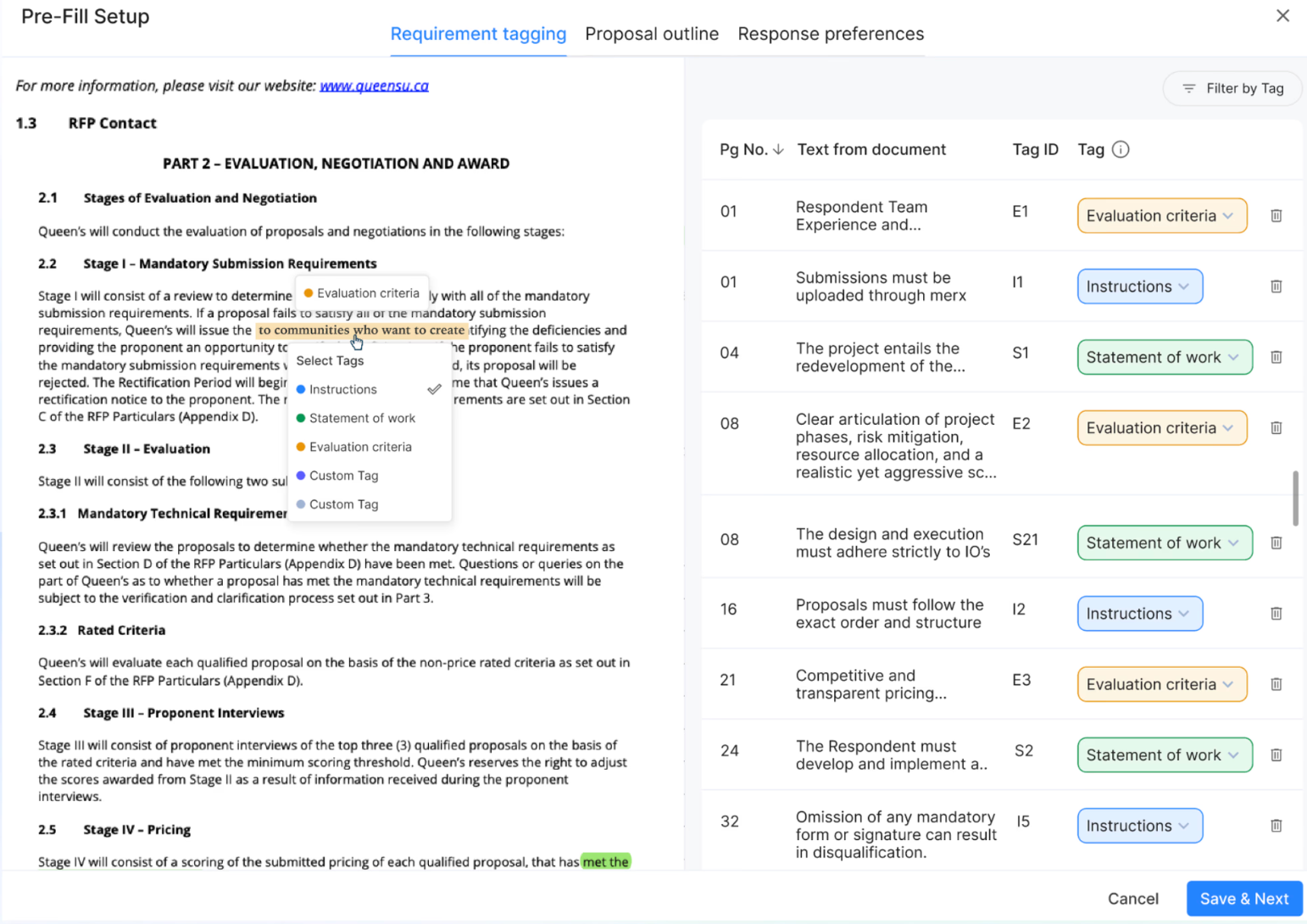RFP ChatGPT Prompts: 7 Ways to Write Proposals Faster with an AI Alternative

The way organizations respond to Requests for Proposals (RFPs) is shifting at record speed and not a moment too soon. Only 6.8% of proposal writers say they’re happy in their role (Source: Happiness Index, Strategic Proposals, 2025).
Why? Traditional proposal management is riddled with Content Library clean-ups, endless SME follow-ups, copy-paste boilerplate, and hours lost chasing compliance details across systems. In many Proposal teams, this manual process consumes more energy than the pitch itself.
AI tools, especially generative AI, AI agents, and retrieval-augmented generation (RAG) are rewriting that story. Modern RFP processes are becoming conversational, intelligent, and automation-driven. They replace slow, click-heavy workflows.
Here’s the difference:
- With ChatGPT: You start from scratch every time. Each prompt produces a different style, tone, and level of detail, making response management inconsistent without heavy editing.
- With Agentic AI RFP Platforms like Thalamus AI: You pre-prompt - a few clicks that set the right context, tone, and compliance rules before drafting even begins. The result? Every draft starts 70% done, grounded in your approved knowledge base and industry-specific standards, and tailored to win.
Platforms like Thalamus AI pair domain-trained AI models with multi-agent workflows. They help proposal teams write faster, collaborate better, and improve win rates. Humans stay in control of strategy and decisions.
Read more about how Agentic AI RFP Platforms are transforming proposal management here.

Pre-Prompting in Thalamus AI – a few clicks set the perfect context, ensuring your team delivers consistent, accurate, and win-ready proposal responses.
Want to see how pre-prompting and agentic AI can cut your RFP response time by 70%? Schedule a Demo of Thalamus AI and watch how Agentic AI workflows turn complex RFPs into win-ready drafts in minutes.
This blog shows you how to use RFP ChatGPT prompts effectively and why proposal teams outperform when they graduate to multi-agent AI RFP software.
We’ll cover:
- 7 proven prompts you can try today
- Where ChatGPT shines (and where it stalls)
- How Agentic AI delivers consistent, compliant, win-focused responses at scale
7 Proven RFP ChatGPT Prompts You Can Try Today
If you’re using ChatGPT for proposal writing, the right prompts can definitely speed things up. But here’s the catch: with ChatGPT, you start from a blank page every time crafting a new prompt, hoping for consistent results. Thalamus AI changes that with pre-prompting: context, tone, and compliance rules are built in from the start, so every draft begins 70% complete consistent, compliant, and win-ready with just a few clicks. (Source: Thalamus AI Internal Data, 2025 – Based on platform usage metrics across enterprise proposal teams in North America)
1. Executive Summary with Industry Focus
Prompt:
Draft an executive summary for aerospace proposal, emphasizing our ISO 27001, SOC 2 compliance and history of on-time project delivery.
Why it works: Frames your strengths for evaluation criteria from the start.
Thalamus advantage: Auto-pulls past aerospace wins, compliance details, and delivery metrics from your Centralized Content Library.
2. RFP Requirement Shredding
Prompt:
Summarize the key requirements from this RFP and tag them as: Statement of Work, Instructions, and Evaluation Criteria.
Why it works: Helps with proposal process planning and SME assignment.
Thalamus advantage: Document Analysis Agent tags requirements automatically, mapping them to SMEs.

3. Compliance-First Boilerplate
Prompt:
Write boilerplate content for the security questionnaire section based on SOC2 and ISO 27001 standards.
Why it works: Addresses security questionnaires accurately.
Thalamus advantage: Pulls pre-approved compliance matrices, no rewording risk.
4. Tone & Style Refinement
Prompt:
Rewrite this RFP response in a persuasive, client-focused tone without changing factual accuracy.
Why it works: Matches proposal writing style to client expectations.
Thalamus advantage: Built-in tone adjustment/ Pre-prompting Screen for every section before finalizing.
5. Highlight Winning Differentiators That Match Scoring Criteria
Prompt:
List our top 5 differentiators and win themes for this proposal, focusing on innovation, accreditations, cost-efficiency, and customer support.
Why it works: Aligns with proposal evaluator scoring criteria.
Thalamus advantage: References industry-specific knowledge from previous winning bids. Analyze past proposals in less than 10 seconds.
6. Risk & Mitigation Planning
Prompt:
Identify three potential risks in the implementation plan and propose mitigation strategies.
Why it works: Anticipates evaluation criteria like feasibility and delivery risk.
Thalamus advantage: Pulls proven mitigation strategies from similar past projects.
7. Competitive Intelligence
Prompt:
Research top competitors bidding in the renewable energy sector and summarize their likely strengths and weaknesses.
Why it works: Supports strategic proposal positioning.
Thalamus advantage: Research Agent performs real-time document and web research without manual sourcing.
Pro Tip: While these prompts work in ChatGPT, you’ll spend time re-entering details and hunting for accurate data.
With Thalamus AI, prompts are pre-engineered into the workflow, meaning the right agents, data sources, and content libraries are triggered automatically for faster, more accurate, higher win-rate submissions.
Where ChatGPT Shines (and Where It Stalls)
Generative AI tools like ChatGPT have earned a place in the proposal writing toolkit. For many proposal writers and sales teams, it’s the first AI language model they try when looking to speed up content creation for Request for Proposals (RFPs) or Due Diligence Questionnaires (DDQs).
Areas where ChatGPT Shines
- Fast Idea Generation: Whether you’re building an RFP generator draft, brainstorming win themes, or creating a content plan, ChatGPT delivers instant text that can break writer’s block.
- Content Re-use & Rewording: Helpful for quickly rewriting boilerplate text or rephrasing compliance matrices to match a client’s tone.
- Language Translation & Sentiment Analysis: Ideal for translating proposal sections for international bids or checking if your message feels persuasive or neutral.
- RFP Summary at Speed: When time is short, it can produce a comprehensive summary of long documents, which account executives and sales engineers can read.
(ChatGPT RFP Prompt Example: An AE can paste in the project plan, prompt GPT to “summarize this for executive leadership,” and have a concise brief ready for the next meeting.)
Where ChatGPT Stalls
While powerful, ChatGPT has structural limits that can slow proposal development and impact win rates if not managed carefully:
- Prompt Dependency & Inconsistency
- Every new request starts from scratch, meaning style, tone, and response accuracy vary unless the prompt is perfectly engineered. Evidence: In Thalamus AI’s 2025 usage study, proposal teams reported spending up to 30% more time revising GPT-generated drafts compared to domain-trained AI platforms.
- Lack of Domain Training
- ChatGPT’s training data is broad but not tailored for specialised tender and RFP management systems, B2B SaaS sales, or industry standards in compliance-heavy sectors.
- This leads to generic answers that sales engineers and SMEs must manually adjust.
- No Integrated Workflow Automation
- It can’t automatically pull from your internal repository, assign tasks to team members, handle manual uploads, or manage multi-user collaboration with version control.
- This creates extra work for proposal managers juggling procurement deadlines and pre-sales support.
- Privacy Concerns & Data Usage
- Enterprise AI RFP platforms like Thalamus AI offer strict security controls validated by security credentials as ISO 27001 and SOC2, whereas ChatGPT has data usage limitations that can raise legal review and privacy concerns.
- No Native Integration with Proposal Workflows
- It lacks UX Workflows as
Step 1: Upload RFP
Step 2: Shred Requirements
Step 3: Assign SMEs. - It lacks automation tools like response re-use, automatic resource allocation, or AI-powered matching systems for subject matter experts.
- It lacks UX Workflows as
The Key Takeaway
ChatGPT is a great advanced AI tool for content summarization. It also helps with quick idea generation. However, it does not have workflow automation, domain-trained AI agents, or multi-user collaboration features. AI-powered RFP software like Thalamus AI provides these features.
The difference shows in win rates:
Proposal teams using a domain-trained, agentic RFP platform reported 2.3X higher response accuracy and met procurement deadlines 40% faster compared to teams using ChatGPT alone.
(Source: Thalamus AI, 2025 – Based on enterprise usage across North America.
How Agentic AI Delivers Consistent, Compliant, Win-Focused Responses at Scale
Most proposal writers know the frustration: content that sounds generic, endless back-and-forth with subject matter experts, and a race against procurement deadlines. In fact, 50% of RFx responses are rated off-target and 63% of proposal teams regularly work overtime (Source: Thalamus AI Primary Research, 2025).
That’s where Agentic AI changes the game.
Traditional AI tools or rule-based RFP generators only match keywords. Agentic AI uses generative AI, specialized AI agents, and memory-based learning. This combination helps it produce high-quality, win-ready proposal drafts. It keeps compliance and your brand voice intact.
Here’s how it works at scale:
1. Pre-Built Context and Compliance Matrices
Instead of starting from a blank prompt (as you would in ChatGPT), Thalamus AI’s pre-prompting system automatically applies your compliance matrices, evaluation criteria, and industry standards to every draft. This ensures proposal generation is 70% complete in minutes, with the right tone, company language, and technical accuracy already in place.
2. Domain-Trained AI Agents with Memory
Thalamus AI is powered by 20+ specialized AI agents, from a Bid/No-Bid Agent to a Review & Compliance Agent, each trained on your past proposals, SME edits, and win-loss data. Over time, these agents get smarter, increasing response accuracy and win rates while reducing dependency on manual library upkeep.
3. Multi-Agent Collaboration Across Teams
With human-on-the-loop controls, proposal managers can assign sections to SMEs, track edits, and approve final language, all within the same workflow. Agents collaborate across platforms like Slack, Teams, and Google Drive, ensuring no bottlenecks or lost context.
4. Built-In Workflow Awareness
Agentic AI isn’t just a content generation tool, it understands workflow automation. It knows when to escalate a section for SME input, when to flag compliance reviews, and when to nudge teams for missing data, reducing response time and preventing last-minute fire drills.
5. Consistent Voice, Zero Generic Answers
With Natural Language Processing tuned to your brand voice, Thalamus AI delivers narrative proposals that sound like you, not a generic chatbot. Whether it’s technical sales engineers writing a security questionnaire or account executives crafting executive summaries, tone and style remain consistent.
6. Built for Every RFx Type
Agentic AI adapts to custom proposals, response re-use, and multi-user collaboration. It handles Requests for Information, Due Diligence Questionnaires (DDQs), and multi-hundred-page Requests for Proposals. It manages forms, narrative responses, and compliance-heavy submissions with equal ease.
7. Evidence-Driven Continuous Improvement
Every submission is logged, scored, and analyzed. Business Intelligence Agents track success metrics, compliance gaps, and evaluator feedback, feeding directly into the AI’s training loop to continuously refine future proposals.
Bottom line:
Legacy SaaS platforms and “AI-flavored” tools stop at retrieval. Agentic AI goes further, planning, reasoning, and executing at every step. The result is consistent, compliant, win-focused responses that scale with your team, while giving you more time for strategic work and relationship building.
See how Thalamus AI turns RFP uploads into a tailored, winnable draft in under five minutes - explore the full platform here.
Conclusion: Moving Beyond Prompts to Win-Ready Proposals
Generative AI and Agentic AI RFP platforms are no longer nice-to-have tools, they’re becoming essential for proposal writers, bid managers, and sales teams aiming to improve win rates, reduce turnaround times, and keep compliance airtight.
ChatGPT can help start ideas. However, only specialized agentic AI platforms like Thalamus AI combine pre-prompting, compliance matrices, multi-user collaboration, and centralized content libraries in one place. This helps you scale consistent, compliant, and persuasive proposals.
Stop starting from scratch. Start winning faster.
Book Your Thalamus AI Demo today and see how domain-trained AI agents, and built-in collaboration can help your proposal team deliver consistent, compliant, and persuasive responses, every single time.
If you’re ready to elevate your proposal writing strategy and learn how AI is transforming response management, check out these related reads:
- Read our Top 3 AI Proposal Software in 2026 comparison to see which platform leads in automation, multilingual proposals, and win-rate performance.
- Want to know what’s next in proposal management? Read the 12 RFP Trends Shaping Proposal Management in 2026.
- Still wondering what AI agents really do in proposals? Read our explainer: AI Agents for RFP Automation
- Compare the best AI-powered RFP response platforms for 2025
- Explore the top AI RFP tools for efficient proposal management
